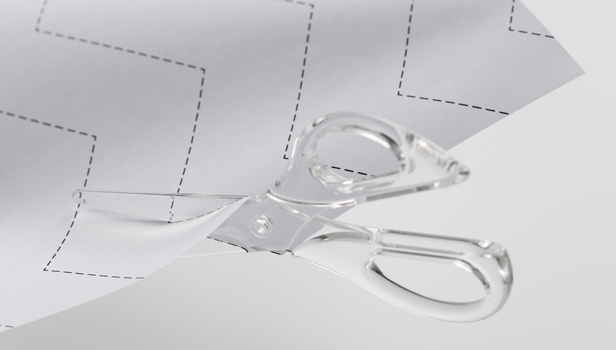KOKUYO DESIGN AWARD 2014

Kokuyo received 1,442 design submissions from around the world.
After narrowing the submissions to 12 of the best in initial judging, one design was selected for the Grand Prix award, with four others selected for Merit Awards.
An official announcement and talk show featuring the Design Award judges followed the conclusion of final judging.
Grand Prix

- title
- sukeru hasami
- creator
- Naoki Ogishita / Koichiro Oishi

Description
When using scissors to cut paper along a line, sometimes the blade of the scissors makes it difficult to see the cut. “sukeru hasami” have clear blades, making for an evolved tool that reduces unnecessary stress.
Making the entire tool--handles and all--from the same clear material provides beauty, productivity, and recyclability in one.
These NEXT QUALITY scissors are a new approach to function and beauty.
Comments by the judges
I can really sense the scale and aspiration behind these high-quality scissors, made entirely from a uniform, clear material. The design reminiscent of a droplet of water was a particular pleasant surprise.
Yōko Kawashima
Every submission was an excellent imagining of this year’s Awards concept. Among them all,
I found the idea to improve the quality of the materials used in traditional scissors by replacing them with clear ceramics to be truly outstanding. This design was absolutely worthy as of the Grand Prix award.
Kashiwa Satō
I believe that the best tools are a natural extension of the human body. While this might be taking it a bit too far, it would be interesting to see scissors that are actually part of the hand. I think this design for scissors is very close to realizing this idea. There's something to the idea of describing the scissors as “see-through” rather than transparent.
Yasuhiro Suzuki
The prototype for this submission was very polished, conveying how nice the product will feel in the hand. The transparency of the material communicates both a stand-offish coolness as well as a translucency that begins to feel like a part of the body. I believe it was this latter factor that most influenced the judges. The design reflects nothing more than the pure function of cutting. I look forward to the potential of this as-yet unseen transparent ceramic, created through a type of sintering process.
Kinya Tagawa
Kokuyo already produces a number of different scissors that are popular on the market. Hit products include a model that can withstand cutting packing tape more than 100,000 times before dulling. Even so, we were impressed with this new concept in scissors. And while we recognize that this is an innovative concept, we are concerned as to whether this can be actually produced. However, the designer included a proposal for a new type of material, which really ignited our excitement. I think this design presents a challenge worth pursuing.
KOKUYO
Merit Award

- title
- eienjogi
- creator
- Manako Kawaguchi

Description
Different sizes and shapes of rulers accomplish different tasks. The " eienjogi " is a tool that lets you draw a single, continuous, endless line. Now, you're never limited by the length of the ruler. This is NEXT QUALITY in a ruler, unlocking the potential of the tool.
Comments by the judges
Drawing a line using a round, rotating ruler is just plain fun. I think the ability to draw a line without limits or measures is a completely unique approach.
Yōko Kawashima
According to Tadataka Ino, who created the map of Japan, the outline of the Japanese archipelago is almost the same distance as the circumference of the planet. And, perhaps the invention of the unit of distance called the meter is a reflection of our innate desire to measure this world. A ruler has a beginning and end, but lines have no end. I think it's a majestic achievement to express this eternal idea in a ruler.
Yasuhiro Suzuki
Consumers tend to like rulers that fit into a pencil case. This design is about the size of a hand, but I think the effort put into the size and shape has improved the function. It would be interesting to see this ruler on the shelf next to traditional rulers.
KOKUYO

- title
- marukezuri
- creator
- Takuma Kawamoto

Description
Pencil tips tend to break immediately after sharpening. This inspired the idea to create a new standard in pencil sharpener that produces a point that makes it easier to write. This isn't just a tool to sharpen writing instruments. It can also be used to sharpen eyeliner pencils, etc.
Comments by the judges
The idea that this design isn’t just for writing instruments but can also be used for eyeliner pencils and other cosmetic applicators demonstrated a bigger vision. I think this is a superb concept.
Yōko Kawashima
I think that it was interesting that the designer convinced me that a pencil is better without a sharply pointed end. Unfortunately, the design of this submission wasn’t particularly intriguing.
I would have liked to have seen the product designed with the ability to choose different shapes for the pencil tip. I think with that addition, this design could have been the Grand Prix winner.
Kashiwa Satō
We were delighted by the fact that this idea came out of a common experience. If the technical issues can be solved, then we believe there are a lot of possibilities here. If the blade could be modified to cut in a more rounded shape, it would be a unique and appealing product. The current design looks a bit too much like other products in terms of shape and color. We'd like to see the designer work on altering the look of the design.
KOKUYO

- title
- honto no jogi
- creator
- Hiroaki Sakai

Description
By showing graduations on a ruler in terms of lines under a geometric definition, rather than by the thickness of the line, we create a ruler that is closer to the true definition of a tool to measure length. This ruler indicates the position of boundary lines created between two faces lined up a regular intervals, providing a more accurate measurement of length.
Comments by the judges
Conceptually, I think this was an amazing idea. My concern is whether making these detailed graduation marks is technically feasible. I also wonder whether people can get used to the feeling of using this product. This might look like a rather plain design, but I believe that it's perfect conceptually.
Kashiwa Satō
The designer was frequently frustrated by wondering which side of the line to cut when using cutting along a line. A discrepancy of even 0.01mm can be a fatal error for a designer, and this design intended to solve this problem is quite ingenious. Despite the fact that the designer only added filler marks in between the graduation lines, the approach was something completely new and apart from traditional rulers.
Kinya Tagawa
The designer here focused on certain features and solutions for an everyday item. You can’t help but be impressed by designer's approach to their work. While the item looks like an ordinary ruler, the ingenuity of the design provides the user with an intuitive grasp of how to use it.
KOKUYO

- title
- Matomeyasui Note
- creator
- Hiroki Nishii

Description
The" Matomeyasui Note" is a notebook divided by colored sections. The user can use these sections to summarize the main points of a lecture or study notes for an upcoming exam. This design improves learning by letting the user summarize the most important facts for easy reference later.
Comments by the judges
The notebook has been subject to all manner of design proposals throughout the years. This submission was the perfect reminder of the need for more specific demonstrations. I think putting this particular design out into the world would spark a generation of new and interesting ideas for the notebook, which is why I was so enamored with this design.
Yasuhiro Suzuki
Adding lightly shaded sections to a notebook is a simple idea, but it has the effect of making it easier for users to take good notes. I think this is an excellent example of changing the quality and nature of an action with a minimum of effort.
Kinya Tagawa
This was a well-conceived, beautiful design. We were most impressed by the function achieved naturally through the design by sectioning the notebook by color. This is an idea that could be in stores tomorrow.
KOKUYO
Genral comments by the judges
* Judge occupations and titles current as of the time the individual served as judge.

Yōko Kawashima
Itochu fashion system Co.,Ltd. ifs FUTURE LABORATORY HEAD CHIEF
The theme of this year’s Awards was NEXT QUALITY, pursuing the next step into the near future for products that have reached maturity. While the theme might seem simple at first glance, it actually involves a high degree of difficulty. I think many of this year's submissions revealed new levels of quality, taking on traditional concepts from a slightly different angle. There were more than a few designs that I would definitely buy if I saw them in the store.
Design is giving a specific shape to a concept or idea for practical use and enjoyment. I hope every designer continues to challenge themselves to discover new design quality.

Kashiwa Sato
SAMURAI INC. Representative / Art Director, Creative Director
The award winners this year were all designs that I would love to use in the real world. Conceptually, they were all very innovative, and I found myself nodding my head in agreement with the ideas. The assumption of the Kokuyo Design Awards is that submissions will be taken to market as actual products. While I think the submissions were at a high level overall, there’s no denying a degree of disappointment that the designs were a bit too practical. They lacked interest in terms of impact, scale, and newsworthiness. This is probably an issue on both sides of the equation: the judges and the designers. I recognize that this bargain—this balance—is difficult to achieve in one’s work in the real world as well.
Given all of these factors, this year’s Grand Prix winner "sukeru hasami" was a design that incorporated both function and beauty. I look forward to seeing this design go through the commercialization process. I think it will be a hit—a product that one would have thought would already be on the market.

Yasuhiro Suzuki
Artist
The theme NEXT QUALITY inspired design submissions offering new value and more than a few surprises. The transparency of the Grand Prix-winning "sukeru hasami" creates an ideal in design where the scissors became less of a separate item and more of a connected whole between hand and tool. The mockup of this design presented a finely studied form balancing constructed beauty and ease of use. The presentation leads one to look forward to using this item in its function as a cutting tool. To me this was a presentation that inspired people look forward to a finished product, rather than merely demonstrating an iteration of item that already exists. I came to realize that NEXT QUALITY is something that leads people to imagine what comes next after seeing a design. I think one can use the medium of familiar stationery or furniture to communicate a new concept. I look forward to the Kokuyo Design Awards becoming a focus for not only designers, but for anyone who has a vision of a concept that could change society.

Kinya Tagawa
takram design engineering Representative / Design Engineer
The word NEXT in the concept of NEXT QUALITY implies something that hasn’t been seen yet. Something unprecedented; quality at a higher level. That was the hope we had when we decided on NEXT QUALITY as the theme for the 2014 Awards.
As a result, we received wonderful submissions that embodied NEXT QUALITY in a wide range of approaches. The Grand Prix winner offered an amazingly pure, detailed design based on a minimalist concept. This year was also notable for the large number of submissions we received from overseas. Unfortunately, none of the overseas submissions were selected as an award winner. But, we are confident that the grand sum of the time and energy devoted to NEXT QUALITY will generate a new approach to quality for future generations.

Akihiro Kuroda
KOKUYO Co., Ltd.
Chief Executive Officer, President and Director
Judging this year's submissions for NEXT QUALITY, we saw that designers went beyond quality, looking to create value through a better user experience as well. We saw quite a number of products with new points of focus. The submissions offered designs that solved traditional sore points in existing products, including fixing nuisances that even users didn't realize they were experiencing. During the final judging process, the designers directly addressed concepts and thoughts that we had never considered before. Obviously, not every submission could win an award, but every submission made a strong argument for the future shape of the nature of quality. This year's Awards emphasized how important a role design can play. We want to express our appreciation to everyone involved.
Final Judging/Winning Design Announcement/Talk Show
Highlights Video
Final Judging
The 12 finalists worked until the very last second, hoping to impress the judges through presentations that incrporated detailed presentation sheets and design models.
The judges listened attentively to the presentations, carefully considering the concepts, design, and market potential of the designs.

Winning Design Announcement
The "sukeru hasami" design was awarded the Grand Prix prize.
A model of the winning design was exhibited in the event hall, as many attendees studied the design with great interest.
Mr. Kinya Tagawa presented the trophy to the winning designer.

Talk Show
The first half of the show focused on NEXT QUALITY as the theme of the 2014 awards, with judges discussing the details that stood out among the winning designs. The second half of the show featured the judges talking about how the role of designers will evolve in the future.
Event attendees were enthusiastic and attentive, listening to the insight of judges currently working across a wide range of fields.

























